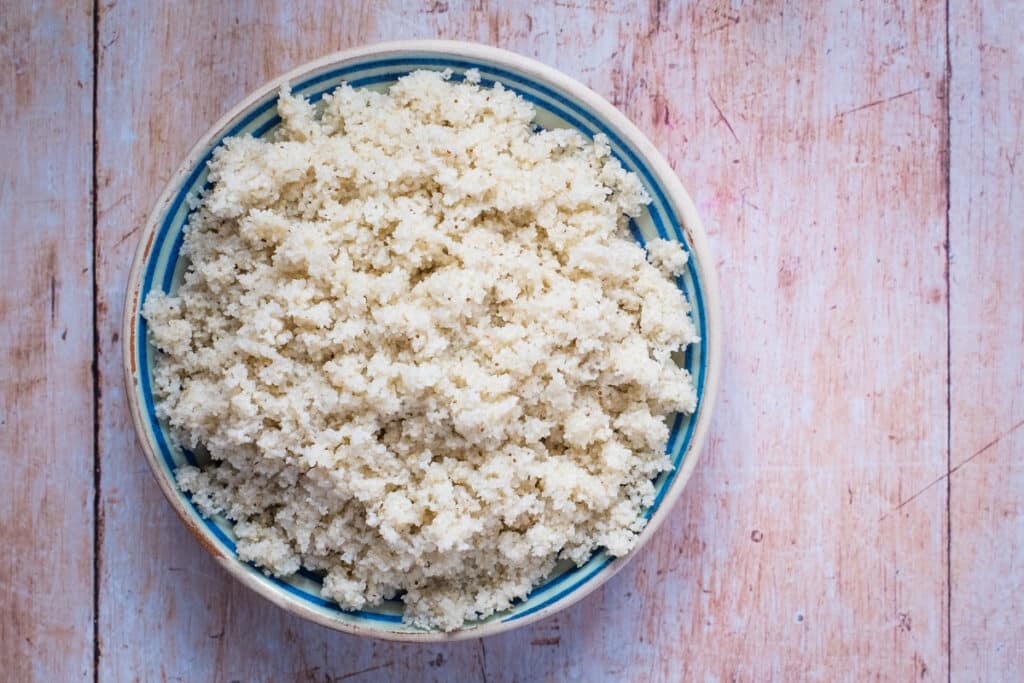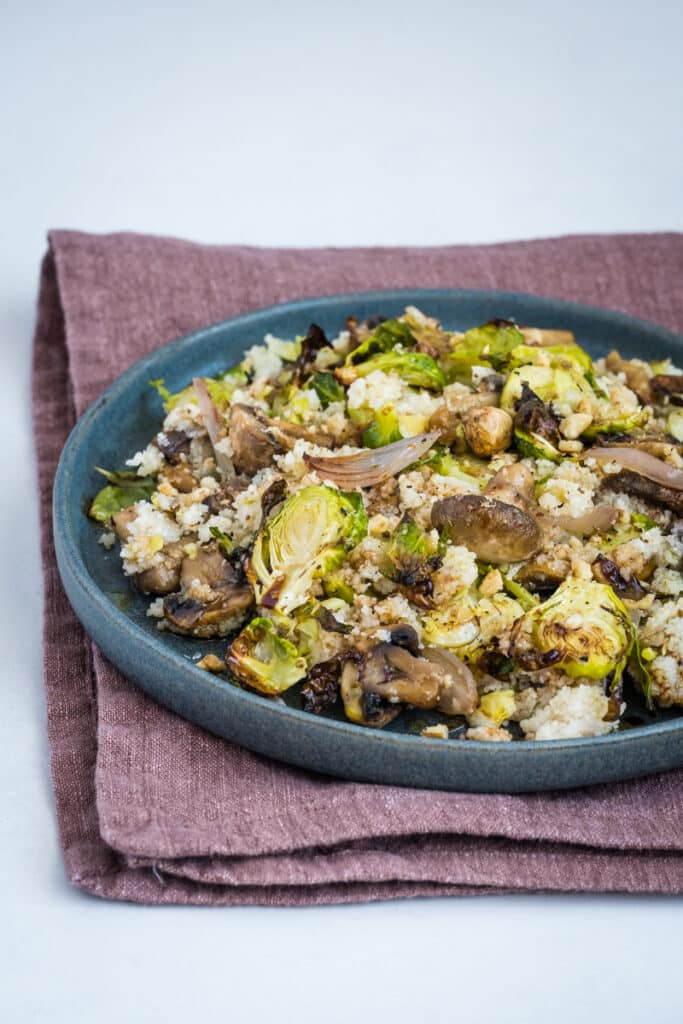Fonio, the smallest member of the millet family and technically a seed, is a highly nutritious and gut-friendly carb that’s perfect for gluten-free and lectin-free diets.
This ancient grain, cherished in West Africa for over 5,000 years, is now gaining recognition in Western cuisines for its unique qualities. Rich in protein and essential amino acids, Fonio is not just healthy but also quick to prepare — taking just five minutes to cook into a light, fluffy dish with a subtle nutty flavor.
Its long-standing cultural significance in West Africa adds to its global appeal as a sustainable and ethical food choice.
What is fonio?
Fonio (Digitaria Exilis) is an ancient grain native to West and Central Africa that is considered healthier and more sustainable than other popular grains or pseudo-grains.
With a tiny grain resembling the texture of granulated sugar, it is the easiest grain to cook because it only takes a few minutes and is also very forgiving.
This super grain can be cooked to be light and fluffy, like couscous, more creamy, like a porridge, or more compact, like a polenta.
It only takes a few minutes on the stove, and that’s one of the reasons it has become my favorite cereal to include in my diet.
Fonio doesn’t have a lot of taste, but it’s very good at absorbing sauces, spices, or other flavors. You can add it to just about any meal.
Eat it the way you would eat rice, couscous, quinoa, millet, or oats.

Is fonio gluten-free?
Yes, fonio is a gluten-free and lectin-free whole grain and a more nutritious addition to your diet than other grains. It is, hence, a wonderful addition to your gluten-free diet if you have celiac disease.
For more information on lectin-free and gluten-free grains, check out our article: The 4 Gut-Healthy, Gluten-Free, and Lectin-Free Grains.
Is fonio the same as millet?
Fonio is a form of small-seeded grass, like millet. Both are from the same family of grasses and are technically seeds, not grains. But conventionally, they are called grains.
Compared to millet, the grain is super tiny, resembling more like granulated sugar.
Is it high in carbs?
45g of fonio (one serving) has 36g of net carbs and 3g of protein. So the answer is, yes, it is high in carbs.
But it is a nutritious alternative if you are gluten-free and lectin-free and don’t eat rice, potatoes, wheat, quinoa, or oats.
The nutritional and health benefits of fonio
While more studies about the nutritional value are needed, it is a good source of fiber, iron, B vitamins, zinc, magnesium, and antioxidant flavonoids. Compared to other grains, it is particularly high in two amino acids— methionine and cysteine.
In West Africa, it is prized by pregnant women and nursing mothers and is often fed as the first solid food for babies.
Fonio is a whole grain with a medium glycemic index (lower than rice, wheat, or sorghum). Because of its lower starch content, high fiber, and nutrient profile, it is considered safe for people with diabetes.
However, you should serve it with fat and protein for slower absorption of carbs. Also, eat your carbs in the first part of the day, and if you have diabetes, use a glucose monitor to measure your response to consuming it.

The cultural significance of fonio
Every time an ancient food gains popularity in Western cuisine, I like to understand the impact that can have on the communities producing that food. In the case of fonio, I contacted one of the most known companies that are bringing it from West Africa, Yolélé.
I love that they support smallholder farmers practicing regenerative agriculture techniques like intercropping, cover-cropping, and crop rotation.
Even when West African farmers can get fonio to market, they face two key problems that prevent them from making money. One is a lack of processing capacity, and the other is low agricultural productivity.
Yolélé is building processing facilities in West Africa and also collaborating with governments, intergovernmental agencies, and NGO’s to train and equip smallholders for increased productivity through conservation farming.
Considering fonio is a drought-tolerant grain and grows well in poor soils, supporting fonio farming the way Yolélé does can be crucial for food security in the region.
Fonio: the seed of the universe
“In West Africa, fonio’s cultural significance has to do with its role in saving lives and alleviating hunger. Fonio’s growing season is short, and it tolerates almost any kind of weather. Subsistence farmers rely on the early harvest to replenish depleted stores of last year’s grain before the current harvest of major crops is ready. This critical role imbues fonio with a powerful image in the cultures who count on it. It’s known as “the seed of the universe”, the root of all existence – like the big bang. It is generally served at harvest time in a celebratory way. Throughout the year, it is served to honored guests, to elders, and to people in poor health due to its easy digestibility and dense nutrition.
For people new to fonio, the best way to celebrate it is to share it. Share the word, and serve the food. Eat it for breakfast every day the way you would oatmeal – it cooks in just minutes! Every usage provides income to smallholder farmers.”
Pierre Thiam, Co-founder and President of Yolélé

Where to buy fonio?
Fonio is still not as popular in The United States or Europe as other grains or pseudo-grains. That’s why you will probably not find it in the average grocery store. However, you will always find a way to order it online from Amazon or other specialty foods suppliers.
There are a couple of options on Amazon US:
How to cook fonio?
Fonio is the easiest and the most forgiving grain to cook. It only takes a few minutes on the stove and can be added to just about any meal.
To cook on the stove, toast 1/2 cup of uncooked fonio in a few tablespoons of oil, and add 1 cup of water. Bring to a boil, and simmer on low heat for 3 minutes. Stir and cover with a lid. After a few minutes, fluff with a fork.
There is a variation I love to use to make a more flavorful fonio. I sautee a couple of shallots in extra virgin olive oil until translucent and fragrant, add the fonio and toast for a minute or so, add double the amount of water, and salt and cook for 3 minutes. Turn the heat off, cover for a few more minutes, grate some Pecorino Romano, add pepper, more salt if necessary, and oregano, and fluff with a fork. Drizzle with more extra virgin olive oil.
Another way to cook it on the stove is to bring 1 cup of salted water to a boil, add 1/2 cup of fonio and lower the heat, cook for 3 minutes, then turn off the heat and cover for a few minutes. Fluff with a fork and serve.
Fonio can also be cooked in the oven, which makes it super fluffy. One of my favorite fonio recipes is Baked Fonio with Pomegranate and Walnut Salsa (see link to recipe below).

How to use fonio
These are a few ways you can use fonio for:
- to make creamy fonio porridge, grits, and polenta
- to make pilaf or any white rice replacement dishes
- to make couscous
- to make tabbouleh salad
- to add to salads and Buddha bowls
- to add to meatballs, vegetarian burgers, or fishcakes
- to add to soups and stews
How to make fonio flour?
You can buy fonio flour, but you can also make it in a blender using a milling blade if you can’t find it.
As flour, it can be used as a thickener or to make gluten-free and lectin-free desserts or baked goods.
Fonio recipes to get you started
These are some of my favorite ways to use fonio in my diet.
Chicken and Fonio with Herb-Avocado Cream
Chicken, fonio, and a green, creamy dressing are all you need for a light, nutritious, refreshing meal. This chicken and fonio platter with herb avocado cream is easy to make, healthy, and can be assembled in various ways, including as a salad.
Vegetarian Loaf with Mushrooms, Fonio, and Parmigiano (Gluten-Free)
This delicious vegetarian loaf recipe with mushrooms and fonio is lectin-free and gluten-free, perfect for meal prep, and super healthy. Not only is it packed with nutritious ingredients, but it’s also bursting with flavor and so easy to make. Whether you’re a vegetarian or just looking for a tasty way to incorporate more plant-based meals into your diet, this recipe is a winner. Plus, this loaf is a smart way to sneak vegetables into food for those peaky eaters in your home.
Baked Fonio with Pomegranate and Walnut Salsa
Perfectly cooked fonio with mint, topped with creamy goat cheese, and a tangy, sweet, and nutty salsa make this dish a vibrant, nutritious, and delicious addition to any meal. It’s so easy; you can make it for a weeknight dinner and sophisticated enough to make it the star of a festive meal. This baked fonio with pomegranate and walnut salsa is perfect as a vegetarian main dish or can be a side dish for any type of meat. Since it can be served warm or cold, it’s perfect for sharing meals, garden parties, and potlucks.
Creamy Fonio Porridge with Almonds and Blueberries
This creamy fonio porridge with almonds and wild blueberries, flavored with toasted coriander seeds, is such a delicate, tasty, and satisfying breakfast or snack. Fonio is an ancient lectin-free and gluten-free, nutritious grain that cooks really fast and can be prepared in a variety of ways.
Conclusion
Fonio stands out as an excellent addition to any culinary repertoire, offering unique benefits for those seeking gluten-free and nutritious grain options.
Not only is fonio naturally gluten-free, but it also boasts a lower glycemic index than other popular grains, making it a favorable choice for individuals managing blood sugar levels. Rich in amino acids, especially methionine and cysteine, and essential nutrients, fonio contributes significantly to a balanced diet with its high protein and fiber content.
Its minimal processing and short cooking time requirements ensure that fonio retains most of its nutritional value, even when cooked. However, to maximize its health benefits, it is advisable to consume fonio in moderation. Fonio’s gentle flavor and versatile nature make it an ideal ingredient in baby food formulations.
As fonio gains popularity globally, it’s vital to recognize and respect its cultural significance in West African societies. Promoting ethical and sustainable practices in the fonio trade is crucial to honoring its heritage and ensuring that its cultivation benefits local communities.
NOTE: This is NOT a sponsored post or an endorsement of any specific company. Do your own research and buy the product that resonates more with you.
*This page contains affiliated links, which means I get a small commission if you choose to purchase something via one of my links, at no extra cost to you.






No Comments